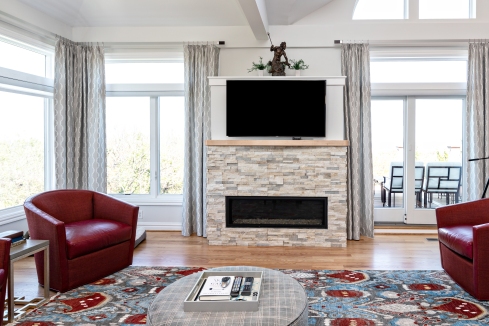Baby, its cold out outside …
Well, maybe not quite yet, but it soon will be, and fireplaces will warm things up, some more than others. But all of them provide coziness and a beautiful focal point to a room, whether traditional or sleek and contemporary. Most homebuyers report wanting a fireplace, which will typically will earn you back more than their initial cost. But the main reason to add a fireplace is to increase the enjoyment for you and your family now, rather than for a future owner of your home. Let’s look at several options for today’s homes because there are pros and cons to all.
Fireplaces generally fall into one of three categories: wood-burning masonry, zero-clearance or pre-fabricated or manufactured, and gas. As you sift through the decisions, be sure to consider budget, function, aesthetics and the style of your home, as well as environmental concerns, both inside and outside your home.
A wood-burning masonry fireplace is the most traditional and most expensive, but what most people think of when they think “fireplace.” Though certainly easier to incorporate into new construction, they can be added to existing homes. Consisting of a brick or stone firebox and a brick or stone chimney, along with a mantel for unlimited decorating potential, these additions require reinforced floor joists, possible enhancement to the existing foundation and footings, and permitting to adhere to codes in your city for chimney height, emissions and construction details.

If you choose this option, you may want an air-circulating system to force warm air back into the room rather than allowing the fireplace to pull heat from your home, potentially increasing heating and cooling costs. Regardless, wood-burning fireplaces pollute, and their chimneys must be cleaned regularly to prevent fire hazards.
Zero-clearance types of fireplaces come in wood-burning, gas, and electric. They do not require a lot of space, and because they are lightweight and their fireboxes stay cool, you have more options for placement, say inches from a hardwood floor or on virtually any wall in your home. Plus, they are easier and less expensive to install than a masonry fireplace.

These fireplaces typically vent through a flexible metal tube, though there are some considerably more efficient models that vent through an external air venting system. The potential drawback to the latter is that they must be placed on an exterior wall. Popular home improvement expert Bob Vila’s formula for determining size is to add the room width and length together and convert to inches, so a room that is 12 by 15 would require a fireplace that has an opening at least a 27 inches wide.
Gas fireplaces may seem inauthentic to traditionalists because they lack that characteristic crackle and aroma, but they may actually provide more warmth in addition to ambiance. They are certainly easier to start and they pollute less than their wood-burning counterparts. Like zero-clearance models, gas fireplaces don’t require a lot of space.

However, they must be near your gas supply line (propane or natural gas) and must be vented either through an existing or new chimney or through flexible metal tubing that leads to the outdoors. Unvented gas fireplaces are growing in popularity, using catalytic converter technology to supposedly burn all of the fuel fed to it, cleanly and with no off-gassing. There is some concern, though, that they do not actually burn 100% of the fuel.
Regardless of your choice, maintenance and cleaning is paramount for safety and functionality. In terms of aesthetics, fireplaces provide endless opportunities to heat up the style quotient of your home. Whether you choose a surround made of brick — painted or maybe with a German smear — tile, say one of the new Moroccan patterns or a reclaimed wood-look plank; stone; or the industrial urban appeal of concrete, your fireplace will provide you with interior design inspiration for years to come. Mantels, after all, are fairly easy to change out and can dramatically alter the entire look of a room, sounding a note that is ultra-traditional, rustic, sleek, or uber-contemporary.
Virginia Beach native and JMU graduate, Chris Ettel, is founding partner of VB Homes. Ettel is a member of the Tidewater Builders Association and is past chairman of the TBA Remodeler’s Council. He can be reached at chris@vbhomesliving.com.

